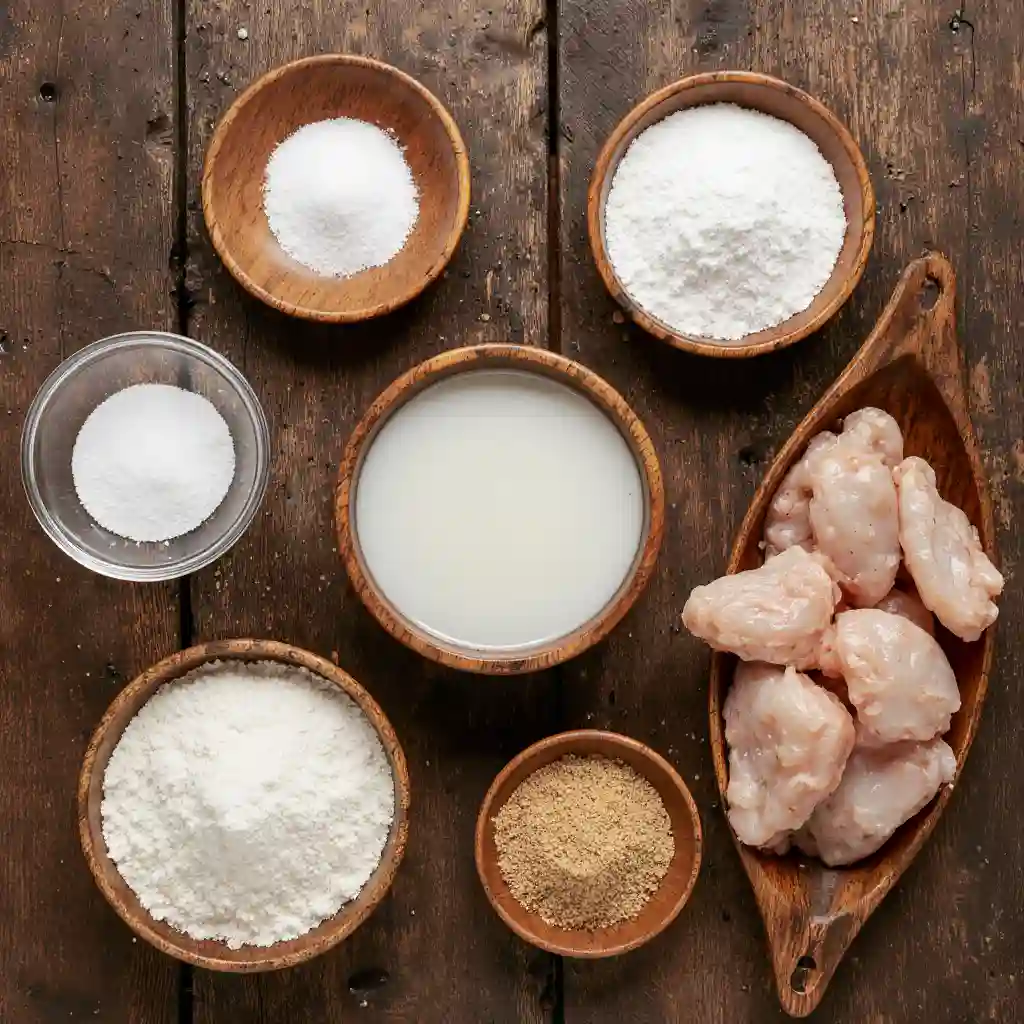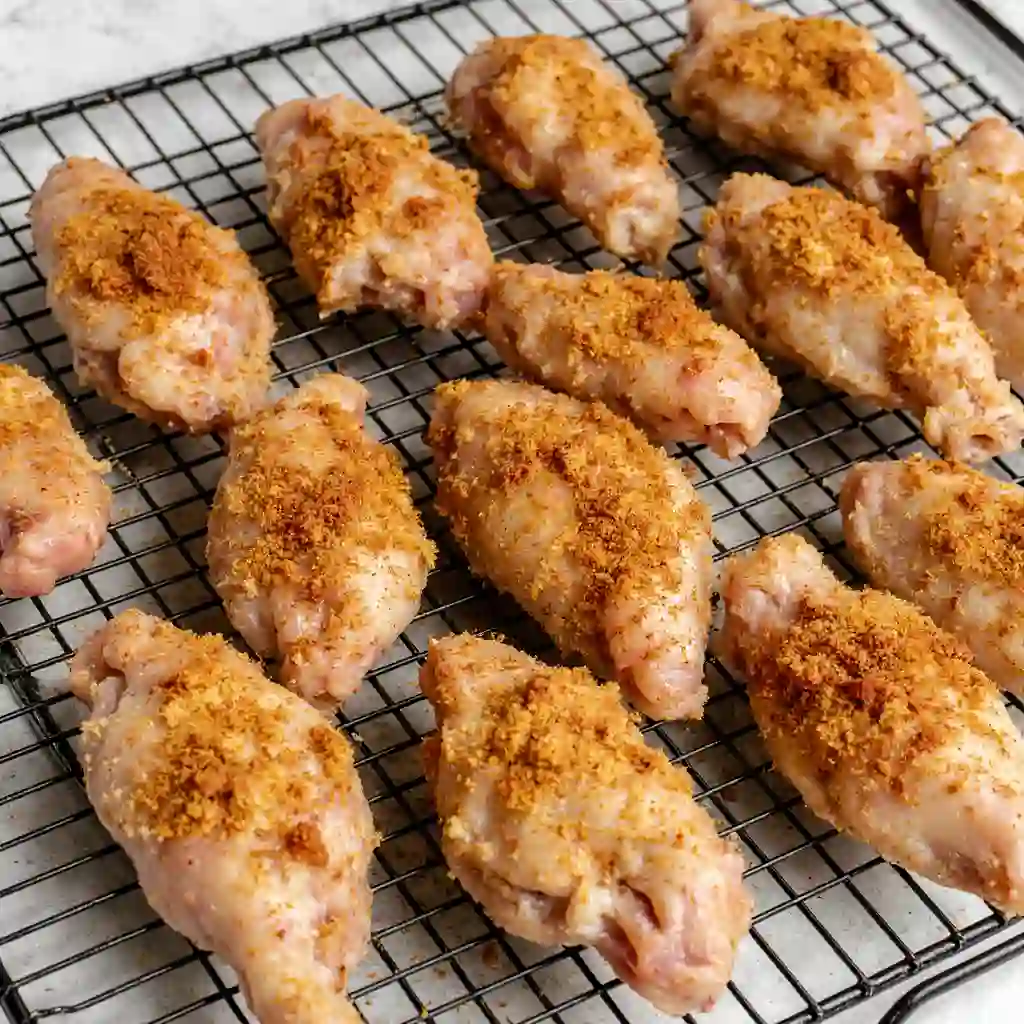There’s something magical about the combination of salt and vinegar. It instantly reminds me of Sunday afternoons when my mom would bring out a tray of hot, crispy chicken wings with a tangy glaze that woke up every taste bud. That balance of sharp vinegar and salty crunch was the first flavor that made me fall in love with cooking. These wings weren’t fancy—but they were bold, bright, and unforgettable. And now, I’ve recreated that nostalgic snack with just a few pantry staples and a couple of flavor-boosting tricks.
This guide walks you through every step to make salt and vinegar chicken wings that are full of flavor, perfectly crispy, and entirely yours to customize—whether you bake, fry, or air-fry. We’ll explore marinating secrets, seasoning hacks, and foolproof ways to keep them crisp. Let’s dig in.
Salt and Vinegar Chicken Wings Recipe: Ingredients & Prep
Pantry Essentials: Salt, Vinegar & Seasonal Basics
At its core, this recipe relies on simple, familiar ingredients you likely already have in your kitchen. The star trio? Coarse kosher salt, white distilled vinegar, and a neutral oil like avocado or canola. But that’s just the start. You’ll also want:
- Chicken wings (drumettes and flats)
- Baking powder (not baking soda—it’s key for crisping)
- Freshly cracked black pepper
- Garlic powder (optional but tasty)
- Cornstarch (for dry rub coating)
- Optional: white sugar or sweet paprika for balance

When choosing your salt, go for something coarse like kosher or Himalayan pink. If you’re into pink salts, check out this Himalayan chicken recipe for more ideas on how to use it with meat.
For the vinegar, standard white is classic, but alternatives like malt, apple cider, or even white wine bring their own twist.
Variations: Apple Cider, Malt, or White Wine Vinegar
Each vinegar lends its own character. Apple cider vinegar gives a mellow tang and slight fruitiness—great if you’re pairing the wings with sweet sides like honey slaw. Malt vinegar adds a pub-style richness, while white wine vinegar is lighter and brighter. Feel free to experiment in small batches to see which one suits your taste. You can also try mixing them for a layered flavor.
For a bold dry rub version, combine a bit of vinegar powder (more on that below) with salt and spices, following this salt and vinegar dry rub method.

Salt and Vinegar Chicken Wings
Equipment
- Wire rack
- Baking tray or air-fryer
- Large mixing bowl
- Tongs
- Meat thermometer
Ingredients
- 1 kg chicken wings (drumettes and flats)
- 2 c. à soupe white distilled vinegar (or apple cider, malt, or white wine vinegar)
- 2 c. à soupe neutral oil (avocado or canola)
- 1 c. à soupe kosher salt or Himalayan pink salt
- 1 c. à café baking powder
- 1 c. à café garlic powder (optional)
- 1 c. à café freshly ground black pepper
- 1 c. à soupe cornstarch (optional for coating)
- vinegar powder (optional for dry rub finish)
Instructions
- Pat the chicken wings dry and place them uncovered on a rack in the refrigerator for 2 to 24 hours to air dry.

- Preheat oven to 220°C (425°F) or set your air-fryer to 200°C (400°F).
- In a bowl, toss wings with vinegar, oil, salt, baking powder, garlic powder, and pepper. Optionally, add cornstarch for crispiness.
- Arrange wings on a wire rack over a baking tray, or in a single layer in the air-fryer basket. Bake or air-fry for 25–30 minutes, flipping halfway.
- Optional: Toss hot wings in a mix of melted butter, vinegar, and chili flakes—or serve dry with a dipping sauce.
- Serve with ranch or blue cheese dip, celery sticks, or slaw. Enjoy warm.
Notes
How to Make Salt and Vinegar Chicken Wings Crispy
Oven-Baked vs Air-Fryer vs Deep-Fry
The method you choose to cook your wings directly affects their crispiness and flavor intensity. Oven baking is great for big batches and minimal cleanup. The skin turns golden and crispy—especially if you elevate the wings on a rack. Use convection mode if your oven has it. Just don’t skip flipping them halfway through.
Air-frying is the fastest and one of the most effective ways to get ultra-crispy skin without much oil. The key here is not to overcrowd your basket. You want hot air to circulate around each wing.

Deep-frying? That’s your ticket to restaurant-level crunch. The skin bubbles, crisps, and holds onto seasoning like a pro. It’s a bit messy and needs careful monitoring, but the payoff is real. Want more crispy chicken inspiration? This spicy crispy baked chicken thighs recipe is another great resource for oven techniques.
Here’s a quick side-by-side:
| Mistake | Details |
| Overcooking | Dries out the meat and toughens the skin. Fix it by cooking just to 165°F using a thermometer. |
| Under-seasoning | Leaves wings bland. Salt is needed to balance vinegar. Use garlic or pepper for extra flavor. |
| Soggy Wings | Happens if wings aren’t dried or are sauced too soon. Always pat dry and toss with sauce after cooking. |
| Too Much Vinegar | Overpowers flavor. Dilute with oil or use vinegar powder instead for a dry, tangy finish. |
Two-Step Cooking & Baking Powder Tricks
No matter your method, the key to next-level crispiness is a two-step approach. First, dry the wings overnight (or at least a few hours) in the fridge uncovered. Second, coat them with a mix of baking powder and salt. Baking powder changes the pH level of the skin and draws out moisture—essential for that delicate blistered crunch.
This technique is great when paired with recipes like cast iron crispy chicken thighs or no breading crispy baked chicken thighs, where simplicity meets technique.
Marinating Techniques for Maximum Flavor
Dry Brine vs Liquid Marinate
Flavor starts long before the wings hit the heat. The right marinating technique is what separates flat flavor from unforgettable zing. For salt and vinegar chicken wings, you have two strong options: a dry brine or a liquid marinade.
A dry brine is simply salting the wings in advance and letting them rest in the fridge, uncovered. The salt pulls moisture from the surface, then lets it soak back in—bringing the flavor deeper into the meat. This also improves texture—giving you firmer, juicier wings with crispier skin. For bonus flavor, toss in apinch of garlic powder, vinegar powder, or crushed herbs from your spice rack. If you’re already a fan of dry rubs, check out this salt and vinegar seasoning guide for even more layering ideas.
A liquid marinade, on the other hand, combines vinegar (any kind) with oil and optional flavor boosters like mustard, chili flakes, or even a little honey. It seeps deeper into the meat, giving you that classic vinegar tang in every bite. Just don’t let the wings soak too long, or the acid can start to break down the meat too much.
Overnight Brining Advantages (2–24 hrs)
Whether you go dry or wet, time is your best friend. A 2-hour rest works in a pinch, but overnight? That’s where the magic happens. You’ll get flavor all the way to the bone and significantly better texture. Keep the wings on a wire rack if possible during the chill—this allows air to circulate and helps the skin start drying out, which sets the stage for a serious crunch.
This method pairs beautifully with techniques like those used in our air-chilled chicken thighs with crispy skin, where time and airflow combine for amazing results.
Coat, Season & Sauce: Achieving that Punchy Finish
Using Vinegar Powder & Cornstarch Rub
After marinating, it’s time to coat the wings for that final pop of flavor and texture. If you’re going for a crispy dry-finish wing, don’t skip the cornstarch rub. A light dusting helps the wings crisp up in the oven or air-fryer without any heavy breading. For best results, mix cornstarch with kosher salt, garlic powder, and a dash of white pepper.
Want to double down on the vinegar flavor? Use vinegar powder in your seasoning blend. It’s a game-changer. Unlike liquid vinegar, which can soften the skin if applied too early, vinegar powder delivers a dry tangy kick right where you want it—on the surface. This makes it ideal for seasoning wings after cooking, especially if you’re going the dry rub route. You can find it in spice shops or online, and it stores well. It’s the same trick we use in our how to make a salt and vinegar dry rub recipe.
Finishing Sauce: Hot Wing Toss vs Reserved Dip
Now, if you’re in the saucy wing camp, you’ve got two main choices: toss the wings right after cooking or serve the sauce on the side.
For the toss, blend a bit of vinegar (white or apple cider), melted butter, and a dash of hot sauce or chili flakes. Do this while the wings are still warm so they soak it all up evenly. Keep it light—just enough to gloss each piece. This works especially well with deep-fried or air-fried wings that can handle a quick dip without going soggy.
Prefer crisp, uncoated wings? Serve a small bowl of reserved dipping sauce instead. This keeps the wings dry and crunchy but gives each bite the option of a vinegary dunk.
Need more flavor-forward crispy ideas? Our paprika herb crusted chicken thighs offer another great take on seasoning after cooking.
Nutrition & Dietary Customizations
Macronutrients Breakdown (Calories, Protein, Fat, Sodium)
Salt and vinegar chicken wings can be surprisingly balanced—especially if you skip heavy coatings or sugar-loaded sauces. On average, 4–5 wings (about 100g cooked) provide:
| Nutrient | Approximate Value |
|---|---|
| Calories | 200–230 |
| Protein | 18–22g |
| Fat | 14–16g |
| Sodium | 400–600mg |
Keep in mind, sodium can climb if you’re using extra salt or commercial sauces. To cut it down, go for low-sodium salt blends or add a splash of citrus to brighten the flavor without more salt. Want to see a healthier twist? This healthy grilled chicken Caesar salad does a great job of keeping flavor while watching macros.
Keto‑, Gluten‑, Low‑Carb & Dairy‑Free Adaptations
These wings fit into plenty of diets with a few smart swaps. For keto or low-carb, just stick to vinegar, salt, oil, and spices—no sugar, no starch. Baking powder is fine, but skip cornstarch or flour if you’re avoiding carbs.
For gluten-free, make sure any spice blends or sauces you use don’t sneak in wheat or malt. Most pure vinegars are safe, but double-check labels—malt vinegar is not gluten-free.
And for dairy-free, these wings are already good to go unless you’re tossing them in butter. In that case, use a dairy-free alternative or olive oil instead. If you’re exploring other clean or anti-inflammatory recipes, this chicken soup with anti-inflammatory herbs offers a gentle, healing option.
Serving Ideas & Pairings with Salt and Vinegar Wings
Classic Game‑Day Sides & Dips
Salt and vinegar wings bring the bold, so sides should balance or complement that tang. Think cool, creamy dips and crisp, fresh textures. A classic pairing is a ranch or blue cheese dip—both cool the palate and work well with sharp vinegar notes.
Crisp veggies like celery and carrot sticks are not just traditional—they actually help cut the richness of the wings. Want something heartier? Go with baked fries, garlic potato wedges, or even sweet potato cubes. These hold their own next to tangy flavors and work well for sharing. For more hearty ideas, check out this creamy garlic chicken pasta with broccoli—especially if you’re building a buffet-style meal.
Creative Twists: Wing Salad, Mashed Potatoes, Slaw
If you’re looking to turn wings into a full meal, try a wing-topped salad with shredded cabbage, thin red onion, and a light vinaigrette. The wings act as the protein while the slaw delivers crunch and zing.
Mashed potatoes may sound unusual, but creamy mash against salty-tangy wings? Surprisingly delicious. Add roasted garlic or sour cream to the mash to keep it savory.
And don’t forget slaw—vinegar-based or creamy. It mirrors the flavor of the wings and keeps the plate from feeling too heavy. If you’re into inventive meals like this, you might also enjoy our spicy grilled chicken Caesar salad prep bowls for another way to layer protein and fresh sides.
Common Mistakes and How to Avoid Them
Overcooking vs Under‑seasoning
Even a simple wing recipe can go wrong without a few key checks. The most common mistake? Overcooking. Whether you’re baking, air-frying, or deep-frying, going too long dries out the meat and makes the skin tough instead of crisp. Always use a meat thermometer and aim for 165°F (74°C) at the thickest part.
Next? Under-seasoning. Since vinegar can overpower, many home cooks hold back on the salt—but that leaves the flavor flat. Remember, vinegar needs salt to shine. If you’re using white vinegar, balance it with generous salt and a hint of garlic powder. For inspiration on seasoning balance, this grilled chicken Caesar wrap recipe shows how a few bold elements can bring everything together.
Soggy Wings, Too Much Salt or Vinegar
Another common slip-up is soggy skin. This usually happens if wings aren’t dried before cooking or if liquid vinegar is added too early. The fix? Pat wings completely dry, use a dry rub, and only toss with sauce right before serving—never during baking.
And yes, too much vinegar or salt can ruin the batch. Taste your marinade before soaking the wings. If it stings your throat or feels overly sharp, it’s probably too strong. Go lighter and adjust after cooking if needed.
Want a method that avoids sogginess while keeping flavor? Check out this helpful recipe for air-chilled chicken thighs with crispy skin—a great example of clean, crisp, well-balanced poultry.
People Also Ask (FAQs)
How do you get vinegar flavor on wings without sogginess?
Marinate first, pat dry, then season after cooking. This locks in flavor while keeping the texture crisp.
Can I use vinegar powder instead of liquid?
Yes. Vinegar powder gives concentrated flavor and works great in dry rubs or post-cooking seasoning.
What’s the best way to reheat wings and keep them crisp?
Use an oven at 200°F or an air-fryer at 400°F for 4–5 minutes. Avoid the microwave—it softens the skin.
Are these wings keto-friendly?
Absolutely. Skip sugar and starch, and stick to vinegar, oil, and spices.
Can I bake without cornstarch?
You can, but you’ll miss out on some crispiness. Cornstarch helps mimic the texture of fried wings.
Final Thoughts
Salt and vinegar chicken wings bring big flavor and real crunch—without the fuss. Whether baked, air-fried, or deep-fried, these wings let you pick your texture while hitting that perfect tangy-salty combo. Use vinegar powder for dry rubs, or go classic with a liquid marinade. Pair with crisp veggies or creamy dips, and you’ve got a game-day winner or family favorite ready to serve.
These wings are simple, fast, and endlessly flexible. Try them once, and they’ll land a spot on your regular menu. Hungry yet? Fire up the oven and make them tonight.







2 thoughts on “Salt and Vinegar Chicken Wings: Tangy Crunch That Impresses”